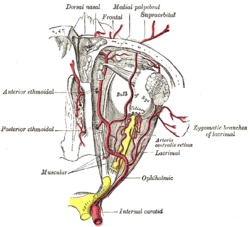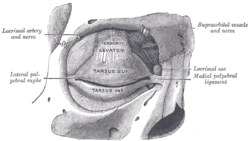Lacrimal artery
| Lacrimal artery | |
|---|---|
 The ophthalmic artery and its branches. (Lacrimal artery visible at center right.) | |
 The tarsi and their ligaments. Right eye; front view. (Lacrimal artery visible at upper left.) | |
| Details | |
| Source | Ophthalmic artery |
| Branches | Lateral palpebral arteries zygomatic branches recurrent branch |
| Supplies | Lacrimal gland, eyelids, conjunctiva |
| Identifiers | |
| Latin | Arteria lacrimalis |
| TA98 | A12.2.06.027 |
| TA2 | 4476 |
| FMA | 49927 |
| Anatomical terminology | |
The lacrimal artery is an artery of the orbit around the eye. It arises close to the optic foramen, and is a branch of the ophthalmic artery. It accompanies the lacrimal nerve along the upper border of the lateral rectus muscle. It supplies the lacrimal gland, two rectus muscles of the eye, the eyelids, and the conjunctiva.
Structure[]
The lacrimal artery is a branch of the ophthalmic artery.[1] It is usually given off after the artery enters the orbit.[2] It accompanies the lacrimal nerve along the upper border of the lateral rectus muscle.[3]
Branches[]
Its terminal branches after the lacrimal gland are distributed to the eyelids and conjunctiva.[2] Of those supplying the eyelids, two are of considerable size and are named the lateral palpebral arteries; they run medially in the upper and lower lids respectively and anastomose with the medial palpebral arteries, forming an arterial circle in this situation.
The lacrimal artery also give off one or two zygomatic branches.[2] One passes through the zygomatico-temporal foramen to reach the temporal fossa, and anastomoses with the deep temporal arteries.[2] Another appears on the cheek through the zygomatico-facial foramen, and anastomoses with the transverse facial artery.[2]
A recurrent branch passes backward through the lateral part of the superior orbital fissure to the dura mater.[2] It anastomoses with a branch of the middle meningeal artery.[2]
Variations[]
The lacrimal artery usually branches from the ophthalmic artery after it enters the orbit.[2] However, it may rarely branch before it enters the orbit.[2] It is sometimes derived from one of the anterior branches of the middle meningeal artery. It shows some variation in course.[4]
Function[]
The lacrimal artery supplies the lacrimal gland.[1] It also supplies the eyelids and the conjunctiva.[2] It supplies the superior rectus muscle, and the lateral rectus muscle, that move the eye.[2]
Additional images[]

Bloodvessels of the eyelids, front view.
References[]
![]() This article incorporates text in the public domain from page 569 of the 20th edition of Gray's Anatomy (1918)
This article incorporates text in the public domain from page 569 of the 20th edition of Gray's Anatomy (1918)
- ^ a b Shindler, Kenneth S. (2019). "18 - Orbital Disease in Neuro-Ophthalmology". Liu, Volpe, and Galetta's Neuro-Ophthalmology - Diagnosis and Management (3rd ed.). Elsevier. pp. 611–658. doi:10.1016/B978-0-323-34044-1.00018-3. ISBN 978-0-323-34044-1.
- ^ a b c d e f g h i j k Remington, Lee Ann (2012). "11 - Orbital Blood Supply". Clinical Anatomy and Physiology of the Visual System (3rd ed.). Butterworth-Heinemann. pp. 202–217. doi:10.1016/B978-1-4377-1926-0.10011-6. ISBN 978-1-4377-1926-0.
- ^ Rea, Paul (2016). "Chapter 2 - Head". Essential Clinically Applied Anatomy of the Peripheral Nervous System in the Head and Neck. Academic Press. pp. 21–130. doi:10.1016/B978-0-12-803633-4.00002-8. ISBN 978-0-12-803633-4.
- ^ Erdogmus, Senem; Govsa, Figen (November 2005). "Importance of the Anatomic Features of the Lacrimal Artery for Orbital Approaches". Journal of Craniofacial Surgery. 16 (6): 957–964. doi:10.1097/01.scs.0000179741.68294.1c. ISSN 1049-2275.
- Wikipedia articles incorporating text from the 20th edition of Gray's Anatomy (1918)
- Arteries of the head and neck
